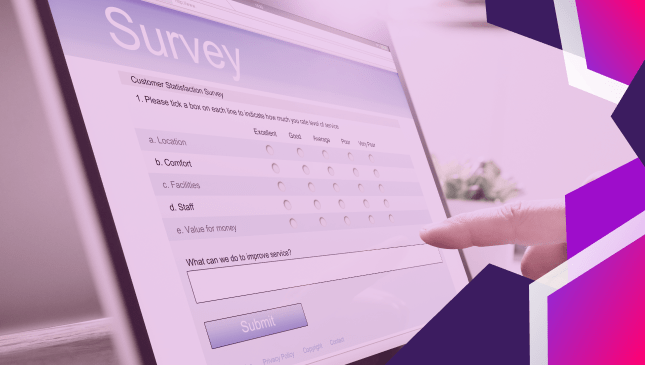Survey Bots Exposed: How They Manipulate Data and Skew Results
Sanja Trajcheva
|Marketing | October 17, 2023

Survey bots are digital imposters that respond to online surveys as regular users. They infiltrate these surveys with irregular and often non-sense data.
Imagine you’re conducting a survey to understand people’s preferences for pizza toppings. You spend hours crafting the perfect questions, publish your survey, and eagerly await the results. But as the responses roll in, something feels wrong.
You start to notice a bizarre pattern: an inexplicable love for anchovies, an unusual liking for pineapple, and an astonishing passion for… sardines?
If you’ve ever encountered a similar situation, it’s likely due to automated responses generated by survey bots.
Unfortunately, online surveys face an increased vulnerability to bots. In this article, we will explore in-depth how these malicious bots operate and provide tips and strategies for protecting your research and data.
Bots for surveys, what are they, and how do they work?
Now, before we unmask these digital pests, let’s start with the basics. Just like other types of bots, survey bots are essentially lines of code created to mimic human activity. In this case, they imitate human responses in online surveys.
These bots can finish surveys quickly and handle lots of them all at once. Fraudsters and bot programmers are constantly finding new ways to make such bot responses as natural as possible. They easily mask bots’ nature by enabling them to give smart and logical responses.
The motivation behind survey bot fraud
As with any other type of malicious bots, survey bots are also used with fraudulent intentions. Usually, they aim to cause harm to businesses or for their own personal gain, such as to win contests or to get rewards from finished surveys in a fraudulent way.
The motivations for hiring survey bots could vary. Some could be hired just for the thrill of messing with data, while others have more harmful goals, like skewing public opinion or manipulating marketing decisions.
Here are some specific examples of how survey bots can be used fraudulently:
- Earning commissions: Some survey sites hire third-party organizations or affiliates to send out surveys to consumers. The survey bots are an attractive option to these third-party organizations to inflate the number of survey participants and earn higher commissions.
- Winning contests: Some survey sites offer prizes or rewards for completing surveys. This can motivate people to use bots to complete surveys multiple times or to submit invalid responses.
- Sabotaging competitors: Competitors may use survey bots to submit invalid survey responses, overload the survey server, or spam survey invitation emails. This can make it difficult for their competitors to collect accurate data.
- Stealing data: Survey bots can be used to collect personal information from survey respondents, such as their email addresses, phone numbers, and home addresses. This information can then be used for identity theft or other malicious purposes.
How did bots compromise a Beekeeping survey for a $20 Amazon gift card?
In 2021, a group of researchers conducted a survey for U.S. commercial beekeepers.
To encourage the beekeepers to take the survey, they offered a $20 Amazon gift card, unknowingly, attracting the attention of fraudsters as well.
The problem arose when a legitimate survey participant, a non-profit organization Project Apis m. promoted the survey on their Instagram account. It didn’t take long for fraudsters and bot operators to detect the opportunity of the gift.
Soon after, the responses flooded in with over 1,200 responses, which was ironically more than the estimated target population of 1,168 beekeepers. It became evident that many of these responses were fake, likely from users trying to get the gift card in malicious ways.
In response to this situation, the researchers implemented a password-protected link. Even after this, the end survey results were alarming. They had accumulated over 2600 responses, of which only 105 (4%) were legitimate.
The impact of fraudulent survey bots
Regardless of their intentions, the result is the same: messed-up surveys and compromised data quality.
The fraudulent answers they provide can have wide-ranging implications for businesses and organizations. And these implications are not just limited to the accuracy of the surveys and skewed data. It can also affect your long-term business decisions and strategies.
Relying on such fraudulent data can result in wasted time and resources, financial losses, damage to reputation, and a decline in client or customer loyalty.
To gain a more comprehensive understanding of these negative effects, let’s break them down in more detail.
Impact on decision-making
In today’s data-driven world, businesses, and organizations heavily rely on the insights garnered from surveys to make informed decisions.
When survey bots distort a business’s data, decisions based on this flawed information can lead to misguided strategies, investments, and resource allocation.
The consequences can range from poor product choices to ill-advised marketing campaigns.
Financial losses
Misinformed decisions can have a direct financial impact. You can end up investing in products, services, or marketing efforts that aren’t aligned with actual consumer preferences, leading to wasted resources and potential financial losses. It’s like ordering a truckload of sardine pizza toppings when your customers despise them.
Reputation damage
When you conduct a survey, it’s not just about collecting data; it’s also about engaging with and understanding your audience.
Using fraudulent data can damage your reputation as a brand. If your customers experience unwanted product changes or even a simple shift in your communication style, they may question your commitment to their needs and preferences.
This erosion of trust can lead to a loss of brand loyalty, which is often challenging to regain.
Negative industry impact
The repercussions of survey bot fraud extend to entire industries. If consumers lose trust in surveys as a reliable tool for feedback and opinion-gathering, it affects market research, public policy decision-making, and more.
Strained relationships
Businesses and organizations often collaborate with survey participants and partners. Survey bot fraud can strain these relationships.
For example, individuals who dedicated their time and effort to participate in the survey may be disappointed if the end results fail to meet their expectations. Let’s say you’re running the survey for preferred pizza toppings.
As a result, you introduce a new pizza flavor to your menu, which is far from the preferences of your existing customers and legitimate survey participants. They may begin to question the relevance of their participation and, as a result, may be less inclined to participate in your future surveys.
Your survey partners, on the other side, have invested considerable time to design, implement, and analyze the survey. If they notice that it ended up with non-sense results, or moreover, spot bot-generated answers, they might not want to collaborate on your next surveys in order to protect their reputation.
The importance of mitigating bot responses in your surveys
Understanding the value of spotting survey bot activity is vital. Think of it as your survey’s security guard. Early detection ensures the reliability of your data, saving you from misguided choices and maintaining the trust of your respondents.
Let’s explore some ways to spot these bots in your survey responses and how you can avoid them.
Tips and strategies for spotting and avoiding bots in surveys
Spotting bots
- Analyze open-ended responses: Bots struggle with open-ended questions, where participants are usually asked to provide their own experiences, thoughts, or ideas. Bots cannot provide meaningful answers in their own words, often responding with incoherent or nonsensical text.
- Monitor response times: Human respondents take time to read and answer questions. If you notice super-fast responses, it might be a sign of bots.
- Check for duplicate IP addresses: Bots often use the same IP address to complete surveys repeatedly. If you see the same IP address completing multiple surveys in a short period of time, it is likely a bot.
- Regularly review data: Keep an eye on your survey results. If you see unusual patterns or sudden spikes in responses, it might be your signal to investigate further.
Avoiding bots
- Use CAPTCHAs: CAPTCHAs are like the first set of guardians that keep bots out of your online property. Integrate them into your survey to filter out automated responses.
- Set up IP address limits: Limit the number of responses from a single IP address to prevent multiple submissions from the same source.
- Implement geolocation checks: Verify that the responses match the expected geographical locations of your respondents.
- Verify respondents for basic qualifications: You could require respondents to be a certain age or to have a certain job title, for example. This can help to reduce the number of bots that are able to start the survey in the first place.
- Educate participants: Inform your survey-takers about the importance of honest answers and discourage fraudulent participation.
With these strategies and tips at your fingertip, you can bolster your survey’s defenses and ensure that the data you collect is accurate and reliable.
If you want to go a step ahead and limit bots from accessing your online property, check these best practices for conducting a cybersecurity audit.
The power of bot detection tools against survey bots
Using a bot detection tool is your first line of defense against bots gaining access to your surveys. These sophisticated software programs can identify and block bots before they even land on your survey.
For example, if you’re running a PPC campaign to promote your survey, an ad fraud detection tool like CHEQ Essentials ensures that bots won’t gain access to it. CHEQ Essentials also comes with a bot mitigation tool that detects and blocks bots from your website. So, if your survey is published on your website, you can rest assured that it’s shielded against fraudulent responses.
The tool employs a range of techniques, such as analyzing user behavior, scrutinizing IP addresses, and employing machine learning algorithms to spot suspicious patterns. Therefore, if you want to maintain the integrity of your data and the reliability of your survey results, these kinds of bot detection and mitigation tools are invaluable.
Grab your 7-day free trial and stay a step ahead of survey bots with CHEQ Essentials.
FAQs:
How can I differentiate between legitimate survey responses and bot answers?
To differentiate between legitimate responses and bot-generated ones, look for patterns such as repetitive, generic, or inconsistent responses. Human answers are more likely to be unique and insightful, which is not the case with bot-generated ones.
The response time can be taken as another sign. Bots often respond to surveys very quickly, while humans may take more time to read the questions and think about their answers.
Are there some legal implications of survey bot fraud?
Yes, survey bot fraud can have legal consequences. For example, it may violate data protection laws, which can lead as a result to legal actions. Businesses should ensure that their survey practices comply with relevant regulations to avoid potential legal issues.
What can I do if I suspect that my survey is being compromised by survey bots?
If you suspect your survey is being compromised by survey bots, take immediate action. Analyze response patterns, look for duplicate IP addresses, implement a bot-detection tool, and, if necessary, seek legal advice.














